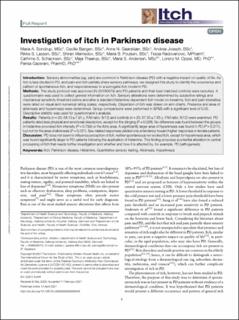| dc.contributor.author | Sondrup, Maria A | |
| dc.contributor.author | Bjergen, Cecilie | |
| dc.contributor.author | Gaarskjær, Anne N | |
| dc.contributor.author | Joseph, Andrea | |
| dc.contributor.author | Lassen, Rikke S | |
| dc.contributor.author | Mamedov, Shiran | |
| dc.contributor.author | Poulsen, Maria B | |
| dc.contributor.author | Radovanovic, Tessa | |
| dc.contributor.author | Schacksen, Cathrine S | |
| dc.contributor.author | Thaarup, Maja | |
| dc.contributor.author | Andersen, Maria S | |
| dc.contributor.author | Oppel, Lorenz M | |
| dc.contributor.author | Gazerani, Parisa | |
| dc.date.accessioned | 2021-06-08T10:07:09Z | |
| dc.date.available | 2021-06-08T10:07:09Z | |
| dc.date.created | 2021-05-25T11:21:56Z | |
| dc.date.issued | 2021-04-14 | |
| dc.identifier.citation | Itch. 2021, 6 (2), 1-12). | en_US |
| dc.identifier.issn | 2380-5048 | |
| dc.identifier.uri | https://hdl.handle.net/11250/2758468 | |
| dc.description.abstract | Introduction: Sensory abnormalities (eg, pain) are common in Parkinson disease (PD) with a negative impact on quality of life. As itch is less studied in PD, and pain and itch partially share sensory pathways, we designed this study to identify the occurrence and pattern of spontaneous itch, and responsiveness to a surrogate itch model in PD.
Methods: The study protocol was approved (N-20180079) and PD patients and their best matched controls were recruited. A questionnaire was used to collect general information on itch. Sensory alterations were determined by subjective ratings and mechanical sensitivity threshold before and after a standard histamine-dependent itch model on forearms. Itch and pain intensities were rated on visual and numerical rating scales, respectively. Dispersion of itch was drawn on arm charts. Presence and area of alloknesis and hyperknesis were determined. Group comparisons were performed in SPSS with a significant level of 0.05. Descriptive statistic was used for questionnaire’s analysis.
Results:Patients(n=20;68.10±7.91y,F/Mratio:8/12)andcontrols(n=20;67.35±7.65y,F/Mratio:8/12)wereexamined.PD patients rated less physical and emotional descriptors, except for the stinging (P = 0.028). No difference was found between the groups in histamine-provoked itch intensity (P = 0.799) or the itchy area. A significantly larger area of hyperknesis was found in PD (P = 0.011), but not for the area of alloknesis (P = 0.221). Sex-related responses yielded only a tendency toward higher responses in female patients. Discussion:PDdoesnotseemtoinfluenceperceptionofitch,neitherspontaneousnorevokeditch,exceptforhyperknesisarea,which was found significantly larger in PD patients following the application of histamine. This finding proposes a potential alteration in central processing of itch that needs further investigation and whether and how it is affected by, for example, PD pathogenesis. | en_US |
| dc.language.iso | eng | en_US |
| dc.publisher | Lippincott, Williams & Wilkins | en_US |
| dc.relation.ispartofseries | Itch;volume 6, issue 2 | |
| dc.rights | Attribution-NonCommercial-NoDerivatives 4.0 Internasjonal | * |
| dc.rights.uri | http://creativecommons.org/licenses/by-nc-nd/4.0/deed.no | * |
| dc.subject | Itch | en_US |
| dc.subject | Parkinson disease | en_US |
| dc.subject | Histamines | en_US |
| dc.subject | Quantitative sensory testing | en_US |
| dc.subject | Alloknesis | en_US |
| dc.subject | Hyperknesis | en_US |
| dc.title | Investigation of itch in Parkinson disease | en_US |
| dc.type | Peer reviewed | en_US |
| dc.type | Journal article | en_US |
| dc.description.version | publishedVersion | en_US |
| dc.rights.holder | © 2021 The Authors. | en_US |
| dc.source.articlenumber | e49 | en_US |
| cristin.ispublished | true | |
| cristin.fulltext | original | |
| dc.identifier.doi | http://dx.doi.org/10.1097/itx.0000000000000049 | |
| dc.identifier.cristin | 1911644 | |
| dc.source.journal | Itch | en_US |
| dc.source.volume | 6 | en_US |
| dc.source.issue | 2 | en_US |
| dc.source.pagenumber | 12 | en_US |

